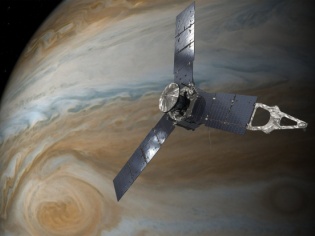-
Malavika Subramanyan
16:18 05th Jul, 2016
Queen And King: Juno Arrives At Jupiter | TechTree.com
Queen And King: Juno Arrives At Jupiter
The NASA spacecraft arrived at the Giant Planet after a five-year sojourn.

“Juno, welcome to Jupiter.” So said mission control commentator Jennifer Delavan of Lockheed Martin, when the NASA spacecraft finally reached her destination on Monday.
Ground controllers at NASA Jet Propulsion Laboratory and Lockheed Martin, which built Juno, burst into applause upon hearing the news from the craft that she was now orbiting Jupiter’s poles.
Juno is the first solar-powered spacecraft to travel as far as she has. Her mission is to obtain a view of Jupiter from inside its dense atmosphere and map out the geographical features of the planet from its vantage position above the poles. Questions abound: how much water is there on Jupiter? Does the planet have a solid core under all that dense gas? What makes Jupiter’s northern and southern lights the brightest in the solar system?
What is the Great Red Spot? The mystery of the huge storm on the planet’s surface, and why it’s been observed to be shrinking of late, may well be solved as a result of Juno’s findings.
Hours before the spacecraft arrived at Jupiter, NASA released a set of photographs taken last week during the approach, showing the planet glowing yellow in the distance, orbited by its four inner moons. Juno’s cameras were switched off on arrival, but NASA has promised to release close-ups of the planet when she crosses the atmosphere.
Jupiter is what scientists call a Gas Giant- a huge ball of hydrogen and helium. It’s likely that it formed before the rest of the planets, shortly after the sun. Understanding Jupiter’s origins and composition may be the key to understanding how Earth and the rest of the solar system developed.
Galileo, a mission launched in 1989, circled the planet for nearly a decade, sending back beautiful views of the planet and its many moons. It discerned signs of an ocean beneath the icy surface of Europa, an important target in the search for life elsewhere in the solar system.
Juno will soon turn her instruments back on, but the actual work will not begin until late August, when the spacecraft moves closer. The plan is for Juno to swoop within 3,000 miles (5,000 kilometers) of Jupiter's clouds to map out the planet's gravitational and magnetic fields in order to learn more about the interior composition. A titanium vault protects her computers and other electronics within the craft; just as well, as Juno is expected to be on the receiving end of radiation exceeding 100 million dental X-rays.
"What Juno's about is looking beneath that surface," Juno’s chief scientist Scott Bolton said before the arrival. "We've got to go down and look at what's inside, see how it's built, how deep these features go, learn about its real secrets."
Juno’s mission ends on 2018; she will deliberately dive into Jupiter’s atmosphere and disintegrate. This is intended to make sure she doesn’t crash into any of Jupiter’s moons, which hold the possibility of habitation in the future
TAGS: NASA Juno, Juno Spacecraft, Jupiter Mission
- DRIFE Begins Operations in Namma Bengaluru
- Sevenaire launches ‘NEPTUNE’ – 24W Portable Speaker with RGB LED Lights
- Inbase launches ‘Urban Q1 Pro’ TWS Earbuds with Smart Touch control in India
- Airtel announces Rs 6000 cashback on purchase of smartphones from leading brands
- 78% of Indians are saving to spend during the festive season and 72% will splurge on gadgets & electronics
- 5 Tips For Buying A TV This Festive Season
- Facebook launches its largest creator education program in India
- 5 educational tech toys for young and aspiring engineers
- Mid-range smartphones emerge as customer favourites this festive season, reveals Amazon survey
- COLORFUL Launches Onebot M24A1 AIO PC for Professionals







TECHTREE